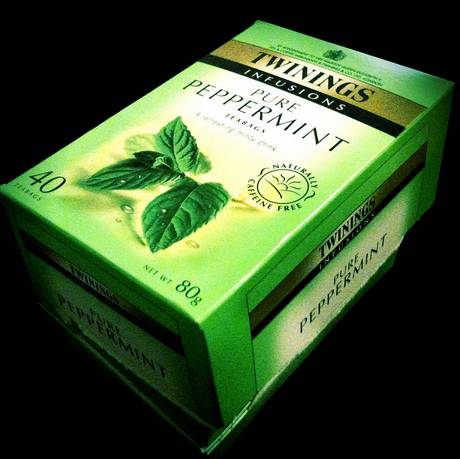Time for coffee and tea
Peppermint tea
Tea Information
Peppermint Tea
Information on how to make herbal tea from mint and of the potential health benefits of drinking the beverage
Peppermint tea is an herbal tea that can either be made from peppermint alone or a mixture of peppermint and tea. It is also referred and known today as mint tea. It can be served hot or cold and it has a caffeine-free taste.
Peppermint (Mentha piperita) is a hybrid between spearmint and watermint.
 Image of peppermint tea bags by James Dennes.
Image of peppermint tea bags by James Dennes.
The plant gives the herbal tea its strong minty aroma because of its high menthol content. Herbal peppermint tea is characterized with its distinctive and superior flavor because of its refreshing menthol taste. Peppermint has volatile oil which is a therapeutic ingredient and it also has vitamin B, potassium, and calcium, go here for a list of calcium rich foods. Peppermint tea is associated with many health benefits because of the healthy contents of peppermint.
Health Benefits of Peppermint Tea
The volatile oil that peppermint contains helps improve digestion. Digestion is important to our health because it is the process in which our body breaks down our substance intakes to be used and excreted to our body system. Peppermint tea also helps ease diarrhea and irritable bowel syndrome or what is known as IBS. It also helps relieve stomachaches and stomach cramps.
The health benefits that peppermint tea is associated with are mainly because of the menthol that peppermint contains. The peppermint tea’s menthol taste and aroma helps fight bad breath and relieve headaches. It also helps ease cough and colds and even mild asthma and treat sinuses and gingivitis. It is also used to relieve stress as well as nausea and vomiting. Gargling with peppermint tea helps treat sore throat.
Peppermint tea’s menthol content can also help suppress bacteria, viruses, and fungi that are produced by diseases.
Peppermint tea also helps optimize the functions of the brain and the nerves because of the vitamin B content of peppermint.
Peppermint tea is also known to help prevent muscle and chronic pains and do away with gallstones. It is even used in baths because it is good for the skin and it helps treat skin ailments.
The steam of peppermint tea is inhaled to have a decongesting therapy.
Preparation of Peppermint Tea
Peppermint tea can be prepared using fresh peppermint leaves or using dried peppermint leaves.
When using fresh peppermint leaves, water is boiled and cooled down before pouring over the peppermint leaves. It is covered while the leaves are soaked in the water for around 7 minutes before it is strained.
When using dried peppermint leaves, two tablespoons of peppermint leaves are added to a cup of hot water. It is covered while the leaves are soaked in the water for around 15 minutes before it is strained.
Honey or fresh lemon juice can be added to the peppermint tea.
Health Issues Associated with Drinking Peppermint Tea
Patients with GERD or gastroesophageal reflux disease should avoid peppermint to avoid stomach contents to move toward the esophagus. It should also be used with caution for those who have gallbladder and liver related ailments and those who have a record of frequent heartburns.
Peppermint tea is a choice of pregnant women who do not want to drink strong teas; but mothers who are still nursing babies should not take too much of it because peppermint can decrease the production of milk.